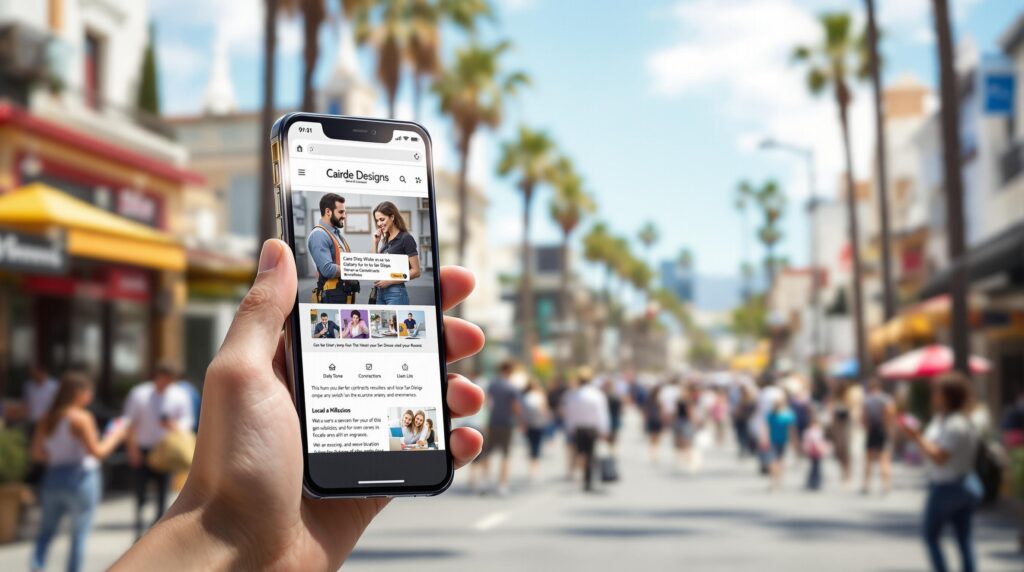Did you know? Improving your mobile site speed by just 0.1 seconds can increase conversions by 8%, and 53% of users will leave if a page takes longer than 3 seconds to load. With over 270 million smartphone users in the U.S., mobile optimization isn’t optional – it’s essential for growing your service business revenue.
Here’s how mobile optimization helps:
- Fast Loading Pages: Faster sites mean higher conversions and lower bounce rates.
- Mobile-Friendly Design: Simplified layouts and clear CTAs drive engagement.
- Local Search Rankings: Optimizing for "near me" searches brings in more customers.
- Mobile-First Design: Prioritizing mobile users ensures better lead generation.
- Mobile Tools: Payment options and messaging features make transactions seamless.
These strategies can turn mobile visitors into paying customers, driving real revenue growth for your business.
Boost Your Website’s Mobile SEO: Top Strategies for 2024 …
1. Fast Loading Pages Keep Customers on Your Site
A faster site can lead to better results. For instance, improving load time by just 0.1 seconds can boost conversion rates by 8%. On the flip side, slow load times drive users away – 53% of visitors will leave if a page takes more than three seconds to load.
How Page Speed Impacts Customer Behavior
Page speed plays a direct role in how customers interact with your site. Here’s why it matters:
- Faster conversions: Pages that load in one second on mobile convert 2.5 times better than those that take four seconds.
- Lower bounce rates: The Economic Times reduced its bounce rate by 43% after improving page speed.
Ways to Improve Your Mobile Site’s Speed
Here are some practical steps to make your site load faster:
- Compress and lazy-load images using tools like Tinify or Imagify, and opt for formats like WebP or SVG.
- Minify your CSS, HTML, and JavaScript files to reduce unnecessary code.
- Upgrade your hosting to VPS or cloud-based solutions for better performance.
- Implement a Content Delivery Network (CDN) to distribute content efficiently.
- Enable browser caching to store static assets locally for repeat visitors.
Use Google PageSpeed Insights to identify and address critical issues (look for the red-triangle warnings first).
Up next, we’ll dive into how mobile-friendly design elements can influence customer actions.
2. Better Mobile Design Gets More Customer Action
A well-designed mobile layout can lead to higher engagement and more conversions.
Simplified Mobile Menus and Layouts
Focus on the essentials in your mobile menus. Highlight key items with clear fonts or underlines, and use a two-level accordion to keep navigation simple without overwhelming users.
Did you know that 57% of users won’t recommend a business with a poorly designed mobile site?
User-Friendly Buttons and Calls-to-Action
- Create short, clear calls-to-action (CTAs) and make buttons large enough to tap easily with a thumb.
- Ensure contact details are visible on every page for quick access.
A smooth mobile experience makes 89% of people more likely to recommend your brand.
Up next: How mobile optimization can improve your local search rankings.
3. Local Search Rankings Bring More Customers
Optimizing for mobile can significantly improve how your business appears in local search results. Since more than two-thirds of Google searches are local, showing up in nearby queries can lead to more calls and visits.
Show Up in ‘Near Me’ Search Results
Searches for "near me" increased by 130% in 2022, and people who find businesses through these searches are 50% more likely to call or visit.
Here’s how to improve your visibility in local mobile searches:
-
Optimize Your Google Business Profile
Make sure your profile includes accurate hours, clear service areas, and quality photos. Keep everything updated and respond quickly to reviews. -
Use Local Keywords
Add neighborhood names, landmarks, and ZIP codes to meta titles, headings, and your website content.
Follow U.S. Formatting Standards
Using proper formatting helps search engines display your business details correctly.
Focus on these key elements:
- Phone numbers in the format (555) 123-4567
- Addresses that match USPS guidelines
- Business hours in a 12-hour format (e.g., 9:00 AM – 5:00 PM)
- Service areas listed by ZIP codes and neighborhood names
“Sixty percent of customers use the Click-to-Call option on Google Business Profile after a ‘near me’ search”.
Additionally, nearly 40% of local "near me" searches come from map apps on mobile devices.
Next, learn how mobile-first design can help turn these local searchers into paying customers.
sbb-itb-e2efe4f
4. Mobile-First Design Gets More Customer Leads
Once you’ve improved local visibility, the next step is turning visitors into customers using mobile-first design. This approach prioritizes smartphones, delivering faster load times, streamlined layouts, and reduced bounce rates. With mobile devices accounting for over 60% of website traffic, a mobile-first strategy can help service providers generate more leads and grow revenue. By combining fast-loading pages and local SEO, you can transform mobile traffic into potential customers.
Features That Help Convert Visitors Into Leads
Here are some key tools to boost lead generation on mobile:
Click-to-Call Buttons
Add visible, clickable phone numbers throughout your site. Since nearly 80% of people contact a local service business within 24 hours of a Google search, this feature makes it easy for potential customers to reach you.
Web Chat Integration
Enable real-time chat to engage visitors instantly and collect their contact details.
Thumb-Friendly Forms
Create forms with larger text and fewer fields, making them simple to fill out on smaller screens.
Streamlined Booking Process
Make Booking Easy
- Add clear "Book Now" buttons.
- Include a real-time availability calendar.
- Offer automated appointment reminders and lead-capture responses.
- Sync with Google or Outlook calendars.
- Provide one-click options for rescheduling.
These features make it easier for customers to book services, increasing the likelihood of converting traffic into leads.
5. Mobile Tools That Increase Sales
After simplifying bookings, take it a step further by adding mobile payment and messaging tools to your site. These features, combined with one-click booking, help turn potential customers into paying clients by making transactions smooth and communication easy.
Mobile Payment Options
Customers now expect to handle payments conveniently from their smartphones. With 58% of buyers regularly using their phones to pay bills, it’s essential for service businesses to offer mobile-friendly payment options.
Key features for mobile payments include:
- Secure payment links for quick transactions
- Mobile-optimized invoices with automated tracking and receipts
- Support for credit cards and bank transfers through contactless methods
Mobile-optimized invoices can boost immediate payment rates by up to 300%. Why? Because they make it incredibly easy for customers to pay on the spot, directly from their phones.
Text Messages and Alerts
Text messaging is a highly effective way to stay connected with customers in real time. A mobile-first messaging approach makes it easier to engage clients, while automated reminders help reduce no-shows and keep everyone on the same page.
For the best results, integrate payments and messaging with your booking, CRM, accounting, review, and marketing tools. This ensures a smooth experience for both your customers and your team, while also increasing the revenue potential of your mobile tools.
Conclusion: Turn Mobile Users Into Paying Customers
Combining these five mobile-focused strategies can directly boost revenue by enhancing user experience and increasing conversions. For example, a multi-location residential cleaning franchise improved its website’s speed in 2020. By 2021, they reported a 32% increase in new users, a 47% rise in phone calls, a 63% jump in free quote requests, and over a 55% revenue growth compared to 2019.
The main areas to prioritize – website speed, mobile-friendly design, local search visibility, lead generation tools, and mobile payment options – work together to effectively turn visitors into paying customers.
Use Google Analytics to track metrics like mobile conversion rates, page load times, local search rankings, lead form completions, and payment completions. Annotate changes to measure their impact clearly.
FAQs
What are some effective tools to optimize my website’s speed and mobile user experience?
Improving your website’s speed and mobile user experience is crucial for attracting and retaining customers. You can use Google PageSpeed Insights to analyze your site’s performance and get actionable recommendations for faster load times. Another option is NitroPack, a tool designed to optimize website speed by managing caching, compression, and image optimization. Additionally, platforms like Duda provide features to create mobile-friendly, high-performing websites tailored to service-based businesses. Prioritizing these tools can lead to better user engagement and higher lead conversions.
How can I measure the impact of mobile optimization on my service business’s revenue?
To measure the impact of mobile optimization on your revenue, start by tracking key metrics in tools like Google Analytics. Focus on mobile-specific data, such as bounce rates, session duration, and conversion rates. Compare these metrics before and after implementing mobile optimization changes to identify improvements.
You can also monitor customer behavior, such as increased mobile inquiries, bookings, or purchases. For a more detailed analysis, set up conversion tracking to directly link mobile interactions to revenue growth. Regularly reviewing these insights will help you understand how mobile optimization is driving results for your business.
How can I optimize my Google Business Profile to attract more local customers?
To attract more local customers, make sure your Google Business Profile is complete, accurate, and engaging. Start by verifying your business information, including your physical address, phone number, business category, and any relevant attributes. Regularly update your business hours, especially for holidays and special events.
Engage with your audience by responding to customer reviews, as this shows you value their feedback. Add high-quality photos to highlight your services, products, or completed projects. These steps help your profile stand out and build trust with potential customers in your area.



